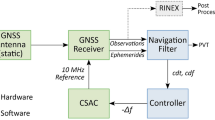Abstract
Wireless Robotics has become an important research topic in the last two decades. The need of controlling a robot to perform tasks remotely has significantly increased with the number of applications in fields like medicine and military, among many others. Taking advantage of current standards like Bluetooth and Wifi, Wireless Robotics calls for low power consumption components, robustness and high data rate through the wireless channel. This call can be fulfilled with a reliable signaling format, satisfying the needs of low power consumption and high spectral efficiency. Besides, continuous phase modulation (CPM) has gained increasing attention due to its favorable trade-off between power and bandwidth efficiency. Multi-h CPM recently appeared as a generalization of single-h schemes so as to further decrease the need for bandwidth expansion over the wireless channel. Despite the interesting characteristics of CPM, the decoding of the received signal is particularly difficult in a multi-path wireless environment with no diversity. To provide some level of diversity, several authors have proposed to combine CPM with space-time block coding. A new family of codes for CPM, based on \(L^2\)-orthogonality was recently introduced in Hesse et al. (IEEE Trans Commun 59(11): 3158–3166, 2011). These full rate codes achieve full diversity and a low decoding complexity. In this paper, we detail a non trivial extension of these \(L^2\)-orthogonal space-time codes using multi-h signaling schemes. These new codes still achieve full diversity but a better spectral compactness by utilizing the available communication bandwidth more efficiently. Also, the decoding complexity is greatly decreased by using only one correlation filter bank for the detection of all transmitted signals.







Similar content being viewed by others
References
Deneire, L., & Lebrun, J. (2012). Continuous Phase Modulation and Space-Time Coding: A candidate for Wireless Robotics. Wireless Personal Communications, 64(3), 473–487.
Aulin, T., Anderson, J. B., & Sundenberg, C. E. (1986). Digital phase modulation. NewYork: Plenum Press.
Aulin, T., Rydbeck, N., & Sundenberg, C. E. (1981). Continuous phase modulation, Part II: Partial response signaling. IEEE Transanctions on Communications, 29(3), 210–225.
Sundenberg, C. E. (1986). Continuous phase modulation. IEEE Communications Magazine, 24(24), 25–38.
Miyakawa, H., Harashima, H., & Tanaka, Y. (1975). A new digital modulation scheme-Multi-mode binary CPFSK. In Proceedings of International Conference on Digital Satellite Communications, 3rd, Kyoto, November 11–13.
Anderson, J. B., & Taylor, D. P. (1978). A bandwidth-efficient class of signal-space codes. IEEE Transactions on Information Theory, 24(6).
Sasase, I., & Mori, S. (1991). Multi-h phase-coded modulation. IEEE Communications Magazine, 29, 46–56.
Alamouti, S. M. (1998). A simple transmit diversity technique for wireless communications. IEEE Journal on Selected Areas in Communications, 16(8), 1451–1458.
Hesse, M., Lebrun, J., & Deneire, L. (2011). L2-Orthogonal ST-code design for CPM. IEEE Transactions on Communications, 59(11), 3158–3166.
Hesse, M., Lebrun, J., Lampe, L., & Deneire, L. (2009). Separable implementation of L2-Orthogonal STC CPM with fast decoding. In IEEE ICC.
Hesse, M., Lebrun, J., & Deneire, L. (2008). Full rate L2-orthogonal space-time CPM for three antennas. In IEEE Conference on Globecom.
Hesse, M., Lebrun, J., & Deneire, L. (2008). L2 orthogonal space-time code for continuous phase modulation. In IEEE Proceedings on ICC.
Tarokh, V., Jafarkhani, H., & Calderbank, A. R. (1999). Space-time block codes from orthogonal designs. In IEEE Transactions on Information Theory, 45(5).
Wang, G., & Xia, X.-G. (2004). An orthogonal space-time coded CPM system with fast decoding for two transmit antennas. IEEE Transactions on Information Theory, 50(3), 486–493.
Ahmadi, A. R., & Rao, R. K. (2005). Design of space-time trellis codes with multi-H CPM signals. In IEEE Canadian Conferences on Electrical and Computer Engineering.
Osborne, W. P., & Luntz, M. B. (1974). Coherent and noncoherent detection of CPFSK. IEEE Transactions on Communications, 22, 1023–1036.
Schonhoff, T. A. (1976). Symbol error probabilities of M-ary CPFSK: Coherent and noncoherent detection. IEEE Transactions on Communications, 24, 644–652.
Premji, A.-N., & Taylor, D. P. (1987). A practical receiver structure for multi-h signals. In IEEE Transactions on Communications, 35(4).
Premji, A.-N., & Taylor, D. P. (1987). Receiver structures for multi-h signaling formats. In IEEE Transactions on Communications, 35(9).
Author information
Authors and Affiliations
Corresponding author
Additional information
The work of M.A. Hisojo is supported by the Mexican Council of Science and Technology, CONACYT. Under the fellowship contract No. 207622.
Rights and permissions
About this article
Cite this article
Hisojo, M.A., Lebrun, J. & Deneire, L. Wireless Robotics: Generalization of an Efficient Approach with Multi-h CPM Signaling and L2-Orthogonal Space-Time Coding. Wireless Pers Commun 70, 1183–1198 (2013). https://doi.org/10.1007/s11277-013-1108-x
Published:
Issue Date:
DOI: https://doi.org/10.1007/s11277-013-1108-x




